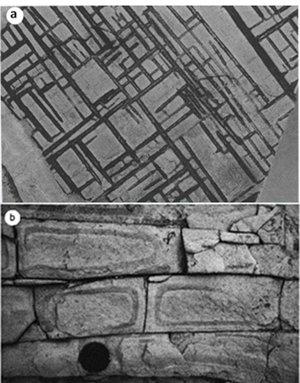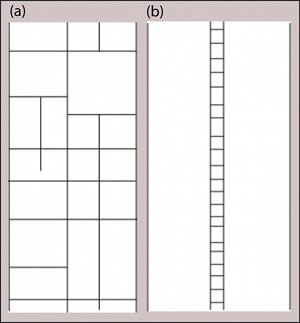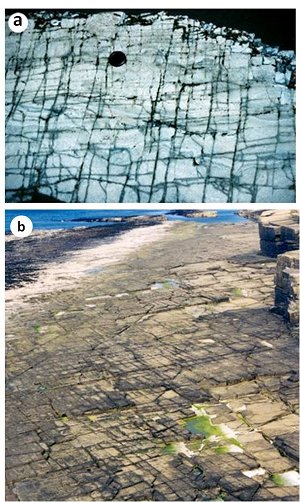| |||||||
|
|
|||||||
|
|
|||||||
| Orthogonal Joint Sets | |||||||
|
Joint sets at right angle to each other are said to be orthogonal (Figures 1a and 1b). They have been observed to have two distinct patterns: grid-like (Figure 2a) and ladder-like (Figure 2b). The former has a chicken wire geometry with mutually abutting discontinuous joints of two sets (Figure 2a), while the latter has a ladder geometry (Figure 2b), with the joints of the longer systematic set defining elongated narrow slabs broken up by younger and shorter orthogonal joints. However, additional infilling joints paralleling the systematic joints in the latter smaller slabs are also possible. The formation of orthogonal joint sets will be discussed under 'Mechanisms and Mechanics of Orthogonal Joints.' For the time being, we just discuss below some interesting joint intersection geometries, which may be confusing in interpreting the relative ages of intersecting joints.
In rare cases, two orthogonal joint sets in a grid-like pattern appear to cross each other (Figures 3a and b). This is of course not possible if the joints have an appreciable aperture, that is, open space between their walls. However, if the joint faces are clamped together by a high joint-normal stress, it is possible that one set may cross the other. The so-called joint-crossing conditions will be described under the joint intersections. Also, if an older set was filled with a material of similar properties as the rock matrix, the new set may cross through the older one. If the infilling material is dissolved and removed at a later time, then the geometry may appear like a younger joint set cutting across an older set as if the joints making up the older set were open at the time of the crossing. It is also possible that joints of a younger set may propagate vertically to the surfaces of the older joints from both sides with lateral alignment, which may give the impression as if the younger set crossed through the older set. This situation is often seen in thermal fractures. | |||||||
| Reference: |
|||||||
| Bai, T., Maerten, L., Gross, M.R., Aydin, A., 2002 Phillips, O.M., 1991 Rives, T., Rawnsley, K.D., Petit, J.P., 1994 |
|||||||
|
Readme | About Us | Acknowledgement | How to Cite | Terms of Use | Ⓒ Rock Fracture Knowledgebase |
|||||||


